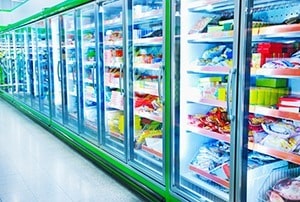What are deep-freeze labels?
Deep-freeze labels: the right choice for labeling in freezing conditions
Not every storage system offers ideal conditions for labels, which need to be subject to special requirements. The task of labels is to enable clear allocation and optimum handling of all types of goods. However, special influences such as regular temperature fluctuations, sunlight etc. continuously wear away at their substance. The result is illegible, smeared or otherwise unusable labels – with all the negative effects on the flow of goods within the warehouse.
This is precisely where deep-freeze labels come in, designed for areas of application with particularly adverse conditions. proLogistik explains the most important aspects and discusses the material composition.
What characterizes deep-freeze labels and distinguishes them from classic labels?
As the name suggests, deep-freeze labels are based on special material properties. They are specially designed for use in environments where extreme temperatures often prevail – as well as fluctuations within a certain range. A conventional label would not be able to withstand these stresses in the long term because the surface would become illegible or the backing material would become brittle. A deep-freeze label, on the other hand, relies on certain materials and adhesives that do not lose their stability or other properties even under adverse conditions.
Here are the most important distinguishing features between a classic label and a frozen food label:
- Use of a cold-resistant material, optionally based on deep-freeze paper, thermo-TK paper, a plastic film or laser-printed paper
- Permanently attached using a special adhesive so that for example the deep-freeze labels adhere securely to products that have already been deep-frozen
- Production processes in the context of direct thermal or thermal transfer printing that allow different background colors (white, yellow, orange, green, light blue) and bar colors (black, blue, green, cyan, brown).
In short: deep-freeze labels are precisely optimized in the aspects so that they can be used to identify warehouses, shelves, pallets or products at any time without any problems.
Are deep-freeze labels removable?
Yes, because specially produced deep-freeze labels can be used for this purpose. These are removable, so they can be stuck or attached to other objects. This means that bins, containers etc. can be used flexibly for precisely the goods in focus. The adhesive leaves no annoying residue on the surface.
Are there special deep-freeze label rolls that can be used to label products quickly?
Yes, this form of deep-freeze label also exists. As a rule, a residue-free removable adhesive is used as well as special adhesive paper from which the prefabricated deep-freeze labels can be removed. The deep-freeze permanent adhesive is designed for temperature fluctuations and maximum temperatures of up to -30° Celsius. This makes them ideal for labeling frozen food packaging, shelf life information or classic labeling of pallets, shelves, warehouses or other products.
What are the advantages of direct thermal and thermal transfer printing?
Depending on the intended use, it makes sense to decide on a specific printing process.
- Direct thermal printing
Traditionally, deep-freeze labels are produced using the direct thermal printing process. Specially designed label printers work directly on a special thermal paper. This eliminates the need for individual components such as toner or ribbons, which makes this process so cost-effective.
Typically, this involves the labeling of shipping packages, receipts etc. – all areas where the low UV resistance of direct thermal printing is not a real disadvantage.
- Thermal transfer printing
The other process already mentioned, thermal transfer printing, is based on the partial application of heat directly to the surface. Several types of treated material can be used, including polyethylene, polypropylene and polyester films as well as paper and textile fabrics. A deep-freeze label produced in this way has a very high durability, enables the sharp reproduction of the motif and is therefore suitable for barcode or barcode labeling as part of product or food labeling.
Used in: permanent labeling of foodstuffs, appliances or quality control marks, as well as shipping or transport components.
